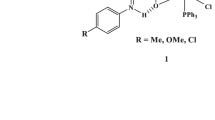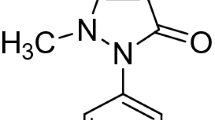Abstract
A fluoro-based Schiff base (E)-2-fluoro-N′-(1-(4-nitrophenyl)ethylidene)benzohydrazide (FNEB) has been synthesized from condensation of 2-fluorobenzohydrazide and 4′-nitroacetophenone catalyzed by glacial acetic acid with ethanol as the solvent. The dipole moment of FNEB in both the electronic states were found using different solvatochromic approaches such as Lippert-Mataga, Bakhshiev, Kawski-Chamma-Viallet, Reichardt and Bilot-Kawski. The experimental ground state dipole moment of FNEB was calculated using Guggenheim-Debye method and theoretical ground state dipole moment using Bilot-Kawski solvatochromic approach. The solvatochromic behavior of the Schiff base in different solvents was studied using absorption and emission spectra. Catalan and Kamlet-Abboud-Taft parameters were used from the multiple linear regression (MLR) analysis in order to study the solute-solvent interaction. The dipole moments were also calculated using Time Dependent-Density Functional Theory (TD-DFT). The chemical stability of FNEB was determined using computational and Cyclic Voltammetry by the use of obtained energy gap between the frontier orbitals. Using the frontier orbitals energy gap, global reactivity parameters were computed. Further, Light Harvesting efficiency was determined to comprehend the photovoltaic property of the Schiff base.









Similar content being viewed by others
References
Drews J (2004) Paul Ehrlich: Magister Mundi. Nat Rev Drug Discov 3:797–801. https://doi.org/10.1038/nrd1498
Strebhardt K, Ullrich A (2008) Paul Ehrlich’s magic bullet concept: 100 years of progress. Nat Rev Cancer 8:473–480. https://doi.org/10.1038/nrc2394
Laguzza BC, Nichols CL, Briggs SL, Cullinan GJ, Johnson DA, Starling JJ, Baker AL, Bumol TF, Corvalan JRF (1989) New antitumor monoclonal antibody-vinca conjugates LY203725 and related compounds: design, preparation, and representative in vivo activity. J Med Chem 32:548–555. https://doi.org/10.1021/jm00123a007
Jarrahpour A, Khalili D, Clercq ED, Salmi C, Brunel JM (2007) Synthesis, antibacterial, antifungal and antiviral activity evaluation of some new bis-Schiff bases of Isatin and their derivatives. Molecules 12:1720–1730. https://doi.org/10.3390/12081720
Rigamonti L (2010) Schiff base metal complexes for second order nonlinear optics. La Chim I’Industria Soc Chim Ital 3:118–122
Grabowski ZR, Rotkiewicz K, Rettig W (2003) Structural changes accompanying intramolecular Electron transfer: focus on twisted intramolecular charge-transfer states and structures. Chem Rev 103:3899–4032. https://doi.org/10.1021/cr940745l
Hayashi R, Tazuke S, Frank CW (1987) Pressure effects on the twisted intramolecular charge transfer (TICT) phenomenon. Chem Phys Lett 135:123–127. https://doi.org/10.1016/0009-2614(87)87228-7
Paczkowski J, Neckers DC (1991) Twisted intramolecular charge-transfer phenomenon as a quantitative probe of polymerization kinetics. Macromolecules 24:3013–3016. https://doi.org/10.1021/ma00010a059
Bajorek A, Pa̧czkowski J (1998) Influence of the attachment of chromophores to a polymer chain on their twisted intramolecular charge-transfer state in dilute solution. Macromolecules 31:86–95. https://doi.org/10.1021/ma970378q
Alphonse R, Varghese A, George L, Nizam A (2016) Estimation of ground state and excited state dipole moments of a novel Schiff base derivative containing 1, 2, 4-triazole nucleus by solvatochromic method. J Mol Liq 215:387–395. https://doi.org/10.1016/j.molliq.2015.12.050
Kumari R, Varghese A, George L, KB A (2016) Photophysical study of 6-amino-3-methyl-4-(4-nitrophenyl)-1,4-dihydropyrano[2,3-c]pyrazole-5-carbonitrile and estimation of ground-state and singlet excited-state dipole moments by solvatochromic approaches. J Mol Liq 222:828–835. https://doi.org/10.1016/j.molliq.2016.07.133
Zakerhamidi MS, Ahmadi-Kandjani S, Moghadam M, Ortyl E, Kucharski S (2012) Solvatochromism effects on the dipole moments and photo-physical behavior of some azo sulfonamide dyes. Spectrochim Acta Part A Mol Biomol Spectrosc 85:105–110. https://doi.org/10.1016/j.saa.2011.09.042
Czekalla J (1960) Elektrische Fluoreszenzpolarisation: Die Bestimmung von Dipolmomenten angeregter Moleküle aus dem Polarisationsgrad der Fluoreszenz in starken elektrischen Feldern. Berichte Der Bunsengesellschaft Für Phys Chemie 64:1221–1228. https://doi.org/10.1002/bbpc.19600641016
Kawski A, Kukliński B, Bojarski P (2005) Dipole moment of aniline in the excited S1 state from thermochromic effect on electronic spectra. Chem Phys Lett 415:251–255. https://doi.org/10.1016/j.cplett.2005.09.008
Czekalla J (1961) Zwei Elektro-Optische Methoden Zur Bestimmung Von Dipolmomenten Angeregter Molkule. Chimia 15:26–31
Patil SK, Wari MN, Panicker CY, Inamdar SR (2013) Solvatochromic study of coumarin 545 in alcohols for the determination of ground and excited state dipole moments. Int J Adv Res 1:616–626
Rauf MA, Hisaindee S (2013) Studies on solvatochromic behavior of dyes using spectral techniques. J Mol Struct 1042:45–56. https://doi.org/10.1016/j.molstruc.2013.03.050
Nicol MF (1974) Solvent effects on electronic spectra. Appl Spectrosc Rev 8:183–227. https://doi.org/10.1080/05704927408060375
Joshi S, Pant DD (2012) Ground and excited state dipole moments of quinine sulfate dication: Solvatochromic shift of absorption and fluorescence spectra. J Mol Liq 172:125–129. https://doi.org/10.1016/j.molliq.2012.04.002
Sharma R, Joshi S, Bhattacharjee R, Pant DD (2015) Solvent effect on absorption and fluorescence spectra of cinchonine and cinchonidine dications: estimation of ground and excited state dipole moments by experimental and numerical studies. J Mol Liq 206:159–164. https://doi.org/10.1016/j.molliq.2015.02.002
Bilot L, Kawski A (1962) Zur Theorie des Einflusses von Lösungsmitteln auf die Elektronenspektren der Moleküle. Zeitschrift Für Naturforsch A 17:621–627. https://doi.org/10.1515/zna-1962-0713
Kawski A, Rabek JF (1992) Progress in photochemistry and photophysics, 5th edn. CRC Press, Boca Raton
Akshaya KB, Varghese A, Lobo PL, Kumari R, George L (2016) Synthesis and photophysical properties of a novel phthalimide derivative using solvatochromic shift method for the estimation of ground and singlet excited state dipole moments. J Mol Liq 224:247–254. https://doi.org/10.1016/j.molliq.2016.09.115
Lippert E, Naturforsch Z (1955) The solvent effect on the spectral shift. Phys Sci 10:541–545
Mataga MKN, Kaifu Y (1945) Berichte der Bunsengesellschaft für physikalische Chemieull. Chem Soc Jpn 29:465–470
Bakshiev NG (1964) Universal intermolecular interactions and their effect on the position of the electronic spectra of molecules in two component solutions. Opt Spektrosk 16:821–832
Kawski A (1966) der Wellenzahl von elecktronenbanden lumineszierenden moleküle. Acta Phys Pol 29:507–518
Chamma A, Viallet PCR (1970) Determination du moment dipolaire d’une molecule dans un etat excite singulet. CR Acad Sci Paris Ser C 270:1901–1904
Reichardt C (1994) Solvatochromic dyes as solvent polarity indicators. Chem Rev 94:2319–2358. https://doi.org/10.1021/cr00032a005
Benchea AC, Babusca D, Morosanu AC, Dimitriu DG, Dorohoi DO (2017) Spectral study of rhodamine dyes in binary solutions. J Mol Struct 1140:71–76. https://doi.org/10.1016/j.molstruc.2016.12.091
Fowler FW, Katritzky AR, Rutherford RJD (1971) The correlation of solvent effects on physical and chemical properties. J Chem Soc B Phys Org 0:460. https://doi.org/10.1039/j29710000460
Kamlet MJ, Abboud JLM, Abraham MH, Taft RW (1983) Linear solvation energy relationships. 23. A comprehensive collection of the solvatochromic parameters, .pi.*, .alpha., and .beta., and some methods for simplifying the generalized solvatochromic equation. J Org Chem 48:2877–2887. https://doi.org/10.1021/jo00165a018
Catalán (2009) Toward a generalized treatment of the solvent effect based on four empirical scales: Dipolarity (SdP, a new scale), polarizability (SP), acidity (SA), and basicity (SB) of the medium. J Phys Chem B 113:5951–5960. https://doi.org/10.1021/jp8095727
Fu J, Zang H, Wang Y, Li S, Chen T, Liu X (2012) Experimental and theoretical study on the inhibition performances of Quinoxaline and its derivatives for the corrosion of mild steel in hydrochloric acid. Ind Eng Chem Res 51:6377–6386. https://doi.org/10.1021/ie202832e
Parr RG, Donnelly RA, Levy M, Palke WE (1978) Electronegativity: the density functional viewpoint. J Chem Phys 68:3801–3807. https://doi.org/10.1063/1.436185
Iczkowski RP, Margrave JL (1961) Electronegativity. J Am Chem Soc 83:3547–3551. https://doi.org/10.1021/ja01478a001
Parr RG, Pearson RG (1983) Absolute hardness: companion parameter to absolute electronegativity. J Am Chem Soc 105:7512–7516. https://doi.org/10.1021/ja00364a005
Parr RG, Szentpály LV, Liu S (1999) Electrophilicity index. J Am Chem Soc 121:1922–1924. https://doi.org/10.1021/ja983494x
Chattaraj PK, Roy DR (2007) Update 1 of: Electrophilicity index. Chem Rev 107:PR46–PR74. https://doi.org/10.1021/cr078014b
Lesar A, Milošev I (2009) Density functional study of the corrosion inhibition properties of 1,2,4-triazole and its amino derivatives. Chem Phys Lett 483:198–203. https://doi.org/10.1016/j.cplett.2009.10.082
Sheela NR, Muthu S, Sampathkrishnan S (2014) Molecular orbital studies (hardness, chemical potential and electrophilicity), vibrational investigation and theoretical NBO analysis of 4-4′-(1H-1,2,4-triazol-1-yl methylene) dibenzonitrile based on abinitio and DFT methods. Spectrochim Acta Part A Mol Biomol Spectrosc 120:237–251. https://doi.org/10.1016/j.saa.2013.10.007
Kolandaivel P, Praveena G, Selvarengan P (2005) Study of atomic and condensed atomic indices for reactive sites of molecules. J Chem Sci 117:591–598. https://doi.org/10.1007/bf02708366
Luque FJ, López JM, Orozco M (2000) Perspective on “electrostatic interactions of a solute with a continuum. A direct utilization of ab initio molecular potentials for the prevision of solvent effects”. M Theor Chem Acta 103:343–345. https://doi.org/10.1007/s002149900013
Okulik N, Jubert AH (2005) Theoretical analysis of the reactive sites of non-steroidal anti-inflammatory drugs. Internet Electron J Mol Des 4(1):17–30
Özdemir N, Eren B, Dinçer M, Bekdemir Y (2010) Experimental and ab initio computational studies on 4-(1 H-benzo[d]imidazol-2-yl)-N,N–dimethylaniline. Mol Phys 108:13–24. https://doi.org/10.1080/00268970903476688
Acknowledgements
The authors would like to thank Anthem Biosciences for FTIR and NMR analyses. The authors express heartfelt gratitude to Indian Institute of Science (IISc), Bengaluru, India for performing the computational analysis.
Funding
This research did not receive any specific grant from funding agencies in the public, commercial, or not-for-profit sectors.
Author information
Authors and Affiliations
Corresponding author
Additional information
Publisher’s Note
Springer Nature remains neutral with regard to jurisdictional claims in published maps and institutional affiliations.
Rights and permissions
About this article
Cite this article
Thadathil, D.A., Varghese, S., Akshaya, K.B. et al. An Insight into Photophysical Investigation of (E)-2-Fluoro-N’-(1-(4-Nitrophenyl)Ethylidene)Benzohydrazide through Solvatochromism Approaches and Computational Studies. J Fluoresc 29, 1013–1027 (2019). https://doi.org/10.1007/s10895-019-02415-y
Received:
Accepted:
Published:
Issue Date:
DOI: https://doi.org/10.1007/s10895-019-02415-y




